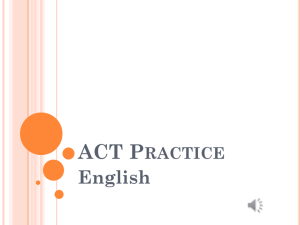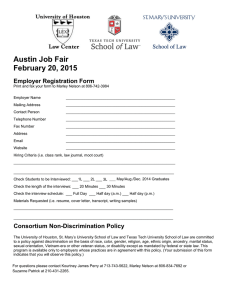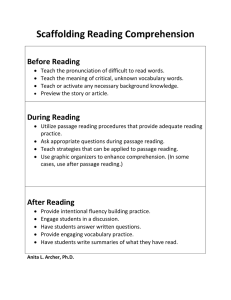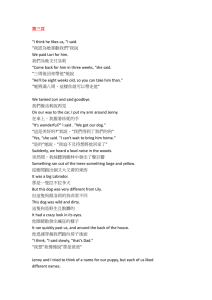Document 14285395
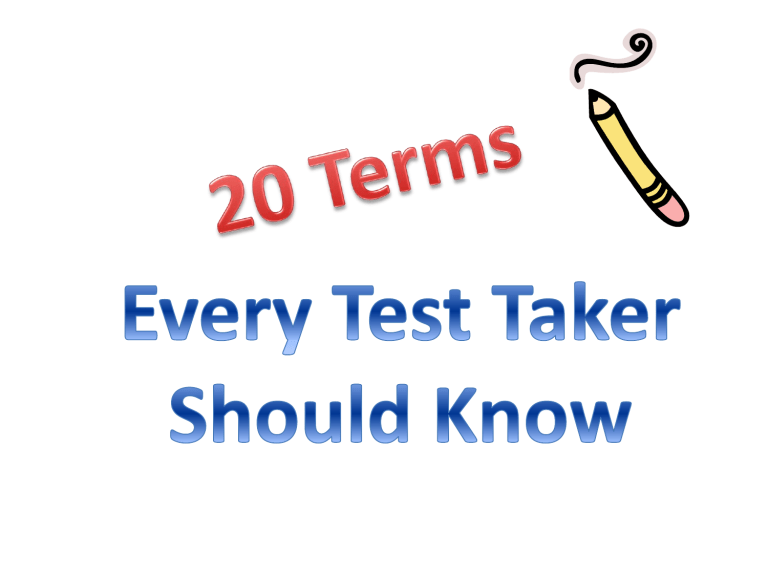
Cause
• The reason something happened is cause.
Effect
• What happened as a result is the effect.
The boy knew the answer, so he raised his hand.
The soccer players wanted a drink of water because the sun was hot.
Compare
• To find ways things are alike is to compare.
Cats
Contrast
• To find ways things are different is to contrast.
Dogs
Chase mice
Meow
Roam freely
Mostly the same size
Play with string
Tail
Fur
Mammals
Pets
4 legs
Collar
Toys
Paws
Chase cats
Bark
Take of a Walk
Vary in size
Play catch
Fact
• A truth that can be proven.
Examples:
George Washington became the
1 st President of the United States in 1789.
The Statue of Liberty was a gift from France.
The Tiger Pistol Shrimp is the loudest animal in the world.
Opinion
• A belief or idea that a person has.
Examples:
George Washington was the best
President that the United States has ever had.
The Statue of Liberty is the most important landmark in our country.
Shrimp is the tastiest type of seafood.
Problem
• A question, dilemma, or issue that needs solving.
Solution
• The answer to the problem, dilemma, or issue.
In the story, Bad Dog Marley, the problem is that Marley keeps damaging things in the house. He is trying to be good, but he is just a puppy. His family is frustrated and is thinking of giving him away. The solution to the problem that Marley saves Baby
Louie and his family realizes he is helpful and that they truly love Marley. They decide to keep him, flaws and all.
Mood
• The feeling the story evokes in the reader.
Tone
• The author’s attitude, stated or implied, toward what he or she writes.
• The choice of setting, objects, details, images, and words all contribute towards creating a specific mood.
• Possible attitudes: pessimism, optimism, seriousness, bitterness, humorous, joyful
• A decision made about information you are given.
Example:
Roberto was stretched out on the floor, putting the finishing touches on his homework. He stacked up his papers, got up, and went to the kitchen for a snack. His mom said, “You’d better not leave those papers on the floor.>
You know how much Yipper likes to chew on paper.” His puppy was sweet, but had not yet learned what was food and what wasn’t.
Roberto replied, “It will only take me a minute to get some cookies.” Then he heard a rustling noise followed by RRRIIIPPP!”
In a very small voice he asked his mom, “Do we have any tape.”
Conclusion: Based on the clues in the story, we can conclude that Yipper ate Roberto’s homework.
• Information and details that make up the passage.
Blue whales live in the Antarctic. Many blue whales have been killed by humans for their
oil. In a few years, there may be none left. This can happen to many other animals if humans are not careful.
• To tell or write about using specific details, adjectives, and figurative language.
Examples:
Her new puppy was a small, white powder puff.
He studied so hard for the exam that all the information was swirling in his head.
• To decide the value or amount of something; to judge.
How would you prove…? Disprove…?
Can you assess the value or importance of…?
What choice would you have made…?
Based on what you know, how would you explain..?
What information would you use to support the view…?
• To make clear or understandable.
What is…?
When did ______ happen?
How did ____ happen?
How would you explain…?
How would you describe…?
How would you show…?
• To give examples or make clear; to paint a picture with words; to show, not tell.
Think of the five senses : how it feels how it sounds how it smells how it looks how it tastes
• To draw a conclusion after reading all information.
The book tells me…
I already know in my schema…
So I infer…
• The most important thing about the passage; what the story or text is mostly about.
Example:
Chocolate is a popular food. Today we think of it mainly as a candy. Years ago, it started out as a drink. All chocolate is made from the beans of the cocoa tree. There are many steps to follow in turning cacao beans into the kind of chocolate we eat.
Main Idea: Making chocolate is a long process.
• An organizer that lists the main points you plan to include in a written answer and the order in which you are going to write them down.
Competitive Swimming, an Ideal Sport for Kids
1.Introduction
2.Competitive swimming provides same benefits as other sports
1. It is good exercise and builds muscular strength
2. It promotes cooperation among team members, especially in relays
3.Competitive swimming provides some additional benefits
1. Swimming is an important skill that can be used forever
2. There is a reduced risk of injury
3. Each swimmer can easily chart his or her own progress
4.My personal experience as a competitive swimmer
1. I enjoy working with my coach
2. I've made a lot of friends on the swim team
5.Conclusion http://www.teachervision.fen.com/writing/essays/1779.html?detoured=1
• To try to get another person to think or feel the same way you do.
• Your goal may be to change your readers' minds or move them to action. Your goal may be to sell a program, defend an idea, or refute an opponent.
• The reason something is done; why the author is writing a passage.
• ENTERTAIN people and make them laugh.
• PERSUADE or CONVINCE readers to believe in something
• INFORM or TEACH you about something.
• The following of one thing after another; the order in which things occur.
First, second, third, fourth
First, next, then, after that, finally
Yesterday, last week , in the future, tomorrow
• To give the main points of the passage.
Include all the important information
Use the author’s key words
Sequence events in the order in which they happened
Make it short and sweet
Tell it in your own words
• To give examples that help prove an answer.
Which statements support…?
Can you explain what is happening…? What is meant…?
What examples can you find to…?
What facts would you select to show…?
How would you classify…?
• The way that a passage is organized.
Compare/Contrast
Cause/Effect
Problem/Solution
Chronological/Sequence
Description
